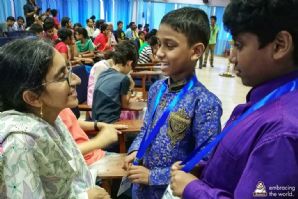
January 14, 2019 - Amritapuri
"From time immemorial, stories have caught the fascination of young and old. In fact, anything and everything we experience can be told as a story," explained Amrita University Professor Gayathri Manikutty. Manikutty is working with AMMACHI Labs as the Robotics 4 Education Academic Coordinator.
"Children, in particular, have a natural way of telling stories that is compelling and emotionally engaging. It enhances their verbal proficiency and makes them reflect deeply upon the theme, thereby enabling them to develop higher-level thinking."
Manikutty says this is what inspired her team to use storytelling as a medium to teach robotics to children in Amrita Vidyalayam schools. The workshop is by AMMACHI Lab's Second Foundation, an education initiative for teaching 21st century skills to school children and young adults in rural India.
The children begin the robotics workshop with the basics of physical computing and design. Through structured play, they learn concepts like finite state machines and how to model them through tangible materials like paper. Next, they move on to LEDs, sensors and actuators--the nuts and bolts of robotics.
"They create paper robots which they program using MIT's Scratch Programming Language. This sets the stage for them to move on to the creative portion of the workshop, namely designing a miniature 3D robotic diorama to tell their story," said Manikutty.
The stories the children write are set upon the theme of how to protect elephants in their natural environments, and the robotics diorama is divided into three scenes.
The students script the narrative from beginning to end and decide what parts will be visual, recorded or dubbed. After that, they work on how to enhance the scenes with light and sound effects. They also paint cut-outs and arrange the robots within the setting.
Finally, it is time for the show, as the audience is waiting. The children tell their story to parents and peers via the robots they have created.
"The children manage the entire process of creating the robotic diorama. This starts with assigning roles and responsibilities to each member of the team, and then producing the diorama within the constraints they face," said Manikutty.
In the big picture, the result is that the children learn essential life and problem-solving skills in the technical context of robotics design. This unique mix ensures that the students begin to build a resilience to the possible events an unpredictable future holds.